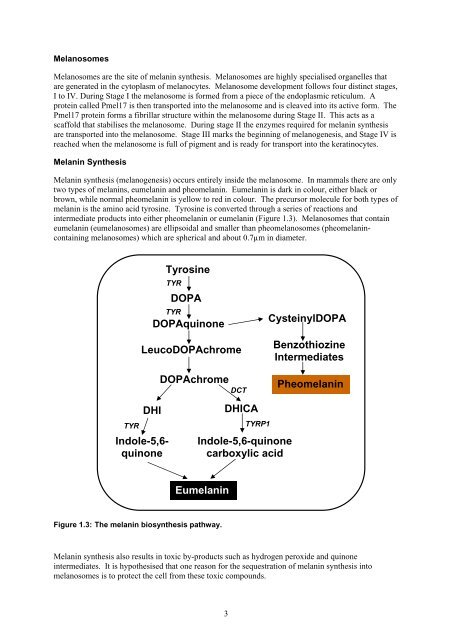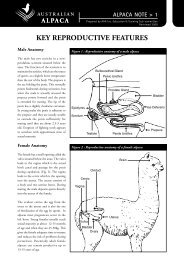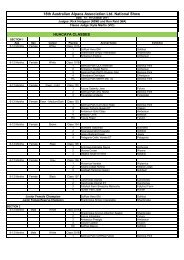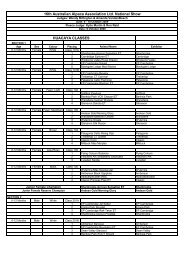Inheritance of White Colour in Alpacas - Australian Alpaca Association
Inheritance of White Colour in Alpacas - Australian Alpaca Association
Inheritance of White Colour in Alpacas - Australian Alpaca Association
Create successful ePaper yourself
Turn your PDF publications into a flip-book with our unique Google optimized e-Paper software.
Melanosomes<br />
Melanosomes are the site <strong>of</strong> melan<strong>in</strong> synthesis. Melanosomes are highly specialised organelles that<br />
are generated <strong>in</strong> the cytoplasm <strong>of</strong> melanocytes. Melanosome development follows four dist<strong>in</strong>ct stages,<br />
I to IV. Dur<strong>in</strong>g Stage I the melanosome is formed from a piece <strong>of</strong> the endoplasmic reticulum. A<br />
prote<strong>in</strong> called Pmel17 is then transported <strong>in</strong>to the melanosome and is cleaved <strong>in</strong>to its active form. The<br />
Pmel17 prote<strong>in</strong> forms a fibrillar structure with<strong>in</strong> the melanosome dur<strong>in</strong>g Stage II. This acts as a<br />
scaffold that stabilises the melanosome. Dur<strong>in</strong>g stage II the enzymes required for melan<strong>in</strong> synthesis<br />
are transported <strong>in</strong>to the melanosome. Stage III marks the beg<strong>in</strong>n<strong>in</strong>g <strong>of</strong> melanogenesis, and Stage IV is<br />
reached when the melanosome is full <strong>of</strong> pigment and is ready for transport <strong>in</strong>to the kerat<strong>in</strong>ocytes.<br />
Melan<strong>in</strong> Synthesis<br />
Melan<strong>in</strong> synthesis (melanogenesis) occurs entirely <strong>in</strong>side the melanosome. In mammals there are only<br />
two types <strong>of</strong> melan<strong>in</strong>s, eumelan<strong>in</strong> and pheomelan<strong>in</strong>. Eumelan<strong>in</strong> is dark <strong>in</strong> colour, either black or<br />
brown, while normal pheomelan<strong>in</strong> is yellow to red <strong>in</strong> colour. The precursor molecule for both types <strong>of</strong><br />
melan<strong>in</strong> is the am<strong>in</strong>o acid tyros<strong>in</strong>e. Tyros<strong>in</strong>e is converted through a series <strong>of</strong> reactions and<br />
<strong>in</strong>termediate products <strong>in</strong>to either pheomelan<strong>in</strong> or eumelan<strong>in</strong> (Figure 1.3). Melanosomes that conta<strong>in</strong><br />
eumelan<strong>in</strong> (eumelanosomes) are ellipsoidal and smaller than pheomelanosomes (pheomelan<strong>in</strong>conta<strong>in</strong><strong>in</strong>g<br />
melanosomes) which are spherical and about 0.7µm <strong>in</strong> diameter.<br />
TYR<br />
Tyros<strong>in</strong>e<br />
DOPA<br />
DOPAqu<strong>in</strong>one<br />
LeucoDOPAchrome<br />
DHI<br />
Indole-5,6qu<strong>in</strong>one<br />
TYR<br />
TYR<br />
DOPAchrome<br />
Figure 1.3: The melan<strong>in</strong> biosynthesis pathway.<br />
DHICA<br />
Indole-5,6-qu<strong>in</strong>one<br />
carboxylic acid<br />
Eumelan<strong>in</strong><br />
Melan<strong>in</strong> synthesis also results <strong>in</strong> toxic by-products such as hydrogen peroxide and qu<strong>in</strong>one<br />
<strong>in</strong>termediates. It is hypothesised that one reason for the sequestration <strong>of</strong> melan<strong>in</strong> synthesis <strong>in</strong>to<br />
melanosomes is to protect the cell from these toxic compounds.<br />
3<br />
DCT<br />
TYRP1<br />
Cyste<strong>in</strong>ylDOPA<br />
Benzothioz<strong>in</strong>e<br />
Intermediates<br />
Pheomelan<strong>in</strong>

















